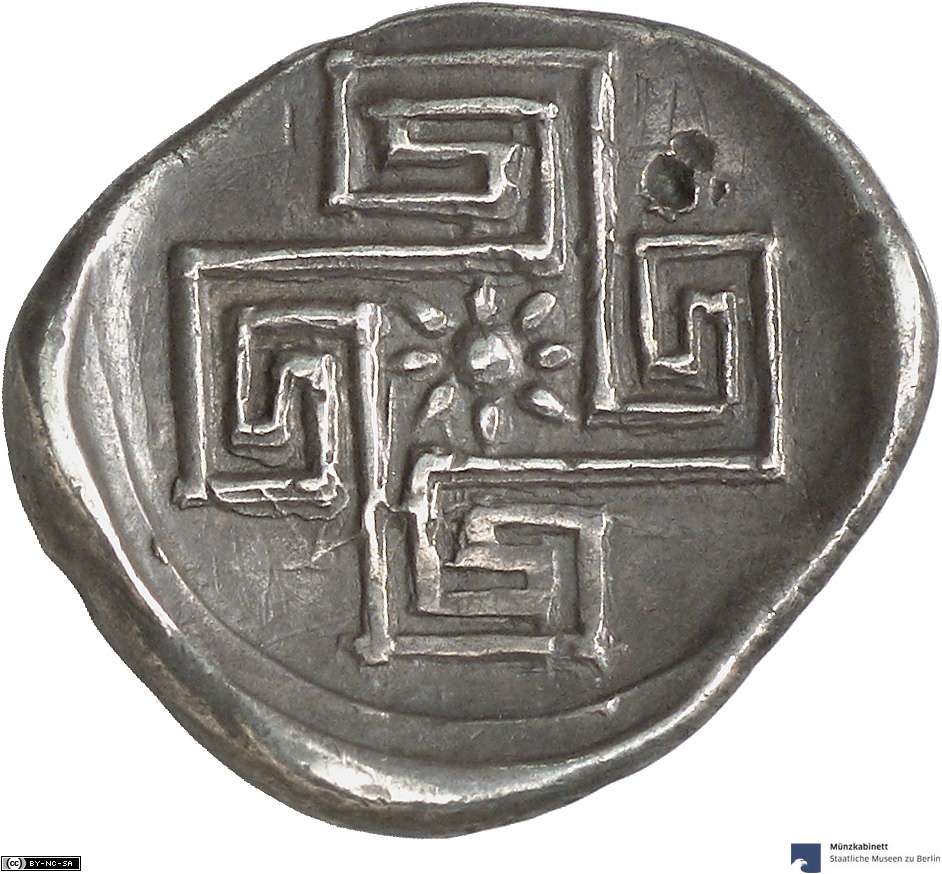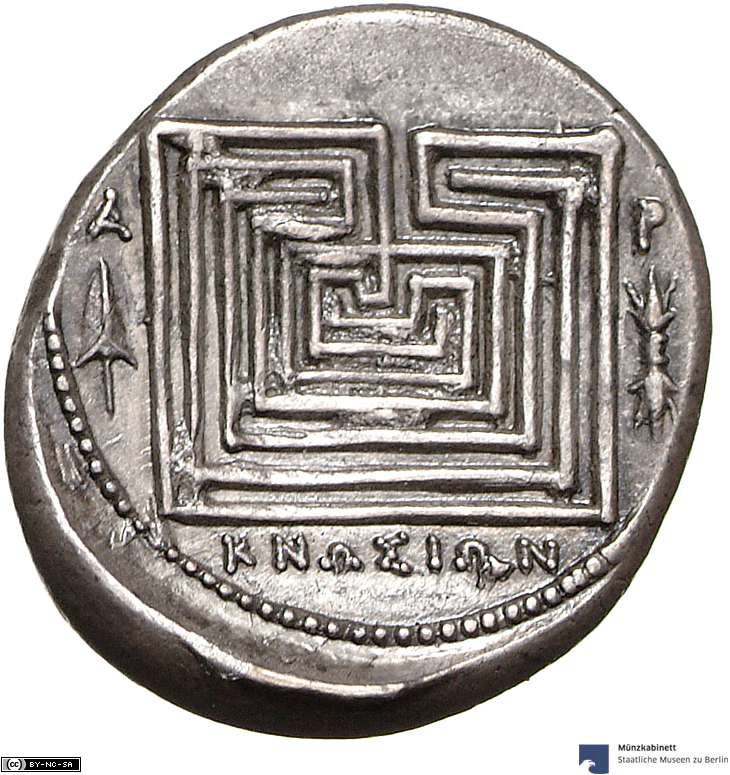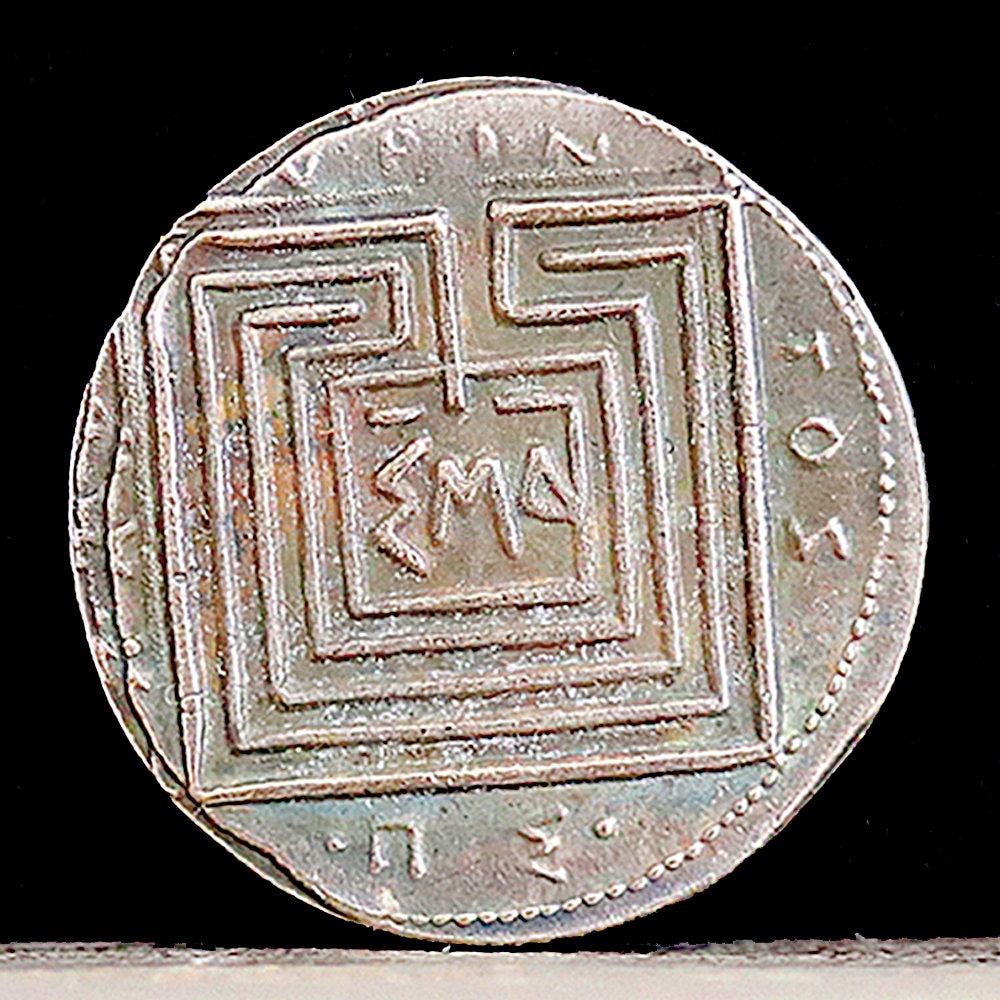Introduction
The ancient Cretan city of Knossos has long been intertwined with the captivating myth of the Minotaur, a half-man, half-bull creature that dwelled within a sprawling labyrinth. This mythical structure, the dwelling place of the Minotaur, has become one of the city’s most iconic landmarks, capturing the imagination of historians, archaeologists, and the general public alike.

What’s particularly intriguing about the labyrinth’s depiction on the silver coins of Knossos is the sheer variety of ways in which it was represented. Spanning a period of over 400 years, from 425 BC to 12 BC, these coins offer a unique window into how the ancient Knossians visualized and portrayed this enigmatic structure. Unlike a real-world place, the labyrinth was a purely mythical construct, and its representation on the coinage reflects the creative freedom and artistic license taken by the coin designers.
In this blog post, we’ll delve into the fascinating world of Knossos’ silver coins, exploring the diverse and often captivating ways in which the labyrinth was depicted. We’ll examine the historical and cultural context that shaped these representations, and uncover the potential meanings and symbolism behind the different designs. Join us on this journey as we unravel the mysteries of the labyrinth’s enduring legacy on the coinage of ancient Knossos.
The Mythical Labyrinth of Knossos
Before we dive into the numismatic depictions of the labyrinth, it’s important to understand the broader context and significance of this mythical structure within the Cretan landscape. The labyrinth was the legendary dwelling place of the Minotaur, a monstrous creature with the head of a bull and the body of a man. According to the myth, the Minotaur was the offspring of Pasiphae, the wife of King Minos of Knossos, and a bull.

King Minos, in an attempt to contain the Minotaur, commissioned the renowned architect Daedalus to construct an intricate, maze-like structure that would house the creature. This labyrinth, with its winding passages and dead ends, was designed to be so complex that no one who entered could ever find their way out.
The labyrinth’s connection to Knossos is further reinforced by the fact that the city was the seat of the Minoan civilization, one of the earliest advanced cultures in the Mediterranean region. Excavations at the site of Knossos have revealed the remains of a sprawling Bronze Age palace, which some archaeologists have speculated may have served as the inspiration for the mythical labyrinth.
Depicting the Labyrinth on Knossos’ Silver Coins
The silver coins of Knossos, minted between 425 BC and 12 BC, provide a fascinating glimpse into how the ancient Knossians visualized and represented the labyrinth. Unlike a real-world structure, the labyrinth was a purely mythical construct, and its depiction on the coinage reflects the creative freedom and artistic license taken by the coin designers.

The Early Depictions (425 BC – 200 BC)
The earliest known depictions of the labyrinth on Knossos’ silver coins date back to the 5th century BC. These early representations tend to be relatively simple, featuring a basic, symmetrical pattern of lines or dots that evoke the idea of a maze-like structure.

One of the most common early designs shows a square or rectangular shape with a series of concentric lines or dots radiating outward from the center. This design likely represents the labyrinth’s winding passages and the challenge of navigating its intricate pathways. Another early motif features a more abstract, circular pattern of lines or dots, suggesting the labyrinth’s circular or spiral configuration.
These early depictions of the labyrinth on the Knossos coins are notable for their minimalist approach, focusing on the essential elements of the mythical structure rather than attempting to recreate it in elaborate detail. This simplicity may have been a deliberate choice, as the coin designers sought to convey the labyrinth’s enigmatic nature and the difficulty of visualizing a non-existent place.
The Evolving Designs (200 BC – 12 BC)
As the centuries passed, the depictions of the labyrinth on the Knossos coins became increasingly varied and complex. During the 2nd and 1st centuries BC, the coin designers began to experiment with more intricate and visually striking designs.
One notable design features a central square or rectangular shape surrounded by a series of concentric, curving lines or arches. This design may have been intended to evoke the labyrinth’s winding passages and the sense of being trapped within its confines. Another design incorporates a more abstract, geometric pattern of intersecting lines and angles, suggesting the labyrinth’s intricate, maze-like structure.

Perhaps the most visually striking depictions of the labyrinth on the Knossos coins are those that feature a more naturalistic, architectural style. These designs often include elements such as columns, arches, or even the suggestion of a building or structure, hinting at the labyrinth’s potential connection to the physical architecture of the Minoan palace at Knossos.
Interestingly, some of the later coin designs also incorporate additional mythological elements, such as the inclusion of the Minotaur itself or other Cretan symbols and motifs. This integration of the labyrinth with broader Cretan mythology and iconography may have been a deliberate choice to reinforce the strong cultural and historical significance of the mythical structure.
The Significance of the Labyrinth’s Depiction
The diverse and evolving depictions of the labyrinth on the silver coins of Knossos offer valuable insights into the cultural and historical significance of this mythical structure. Several key factors may have influenced the coin designers’ choices in representing the labyrinth:
- Artistic Expression and Creative Freedom: As a purely mythical construct, the labyrinth presented the coin designers with a unique opportunity to exercise their artistic creativity and imagination. Without the constraints of depicting a real-world structure, they were free to experiment with a wide range of designs and motifs, each reflecting their own interpretations and visions of the labyrinth.
- Symbolic Meaning: The labyrinth’s depiction on the Knossos coins may have been imbued with symbolic meaning, both for the ancient Knossians and for the broader Cretan culture. The maze-like structure could have represented concepts such as the complexity of the human condition, the challenges of life, or even the journey of the soul.
- Cultural and Historical Significance: The labyrinth’s strong association with the Minoan civilization and the myth of the Minotaur made it a powerful cultural and historical symbol for the people of Knossos. The varied representations of the labyrinth on the coins may have been a way for the Knossians to celebrate and perpetuate this rich cultural heritage.
- Practical Considerations: In addition to the artistic and symbolic factors, the coin designers may have also had practical considerations in mind when depicting the labyrinth. The need to create a visually striking and recognizable design, as well as the technical limitations of coin production, could have influenced the final representations.
Overall, the depictions of the labyrinth on the silver coins of Knossos offer a unique and fascinating window into the ancient Knossians’ understanding and interpretation of this mythical structure. By exploring the evolution of these designs over time, we can gain valuable insights into the cultural, artistic, and symbolic significance of the labyrinth within the Cretan landscape.
Conclusion
The silver coins of Knossos, minted between 425 BC and 12 BC, provide a captivating glimpse into the ancient city’s enduring fascination with the mythical labyrinth. From the early, minimalist designs to the more intricate and visually striking representations that emerged over time, these coins offer a rich tapestry of artistic expression and cultural significance.
As we have explored, the labyrinth’s depiction on the Knossos coins reflects the creative freedom and imagination of the coin designers, who were tasked with visualizing a non-existent, purely mythical structure. The evolution of these designs, from simple patterns to more elaborate, architectural-inspired motifs, suggests a deeper exploration of the labyrinth’s symbolic meaning and cultural importance within the Cretan landscape.
By studying these numismatic depictions, we can gain valuable insights into the ancient Knossians’ understanding and interpretation of the labyrinth, as well as the broader cultural and historical significance of this iconic mythical structure. The labyrinth’s enduring presence on the silver coins of Knossos serves as a testament to its enduring legacy and the captivating power of this enigmatic, maze-like dwelling.
As we continue to unravel the mysteries of the ancient world, the silver coins of Knossos and their depictions of the labyrinth remain a fascinating and invaluable resource, inviting us to delve deeper into the rich tapestry of Cretan mythology and history.
